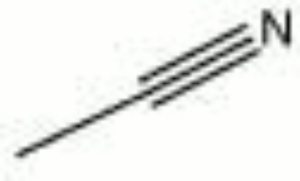Acetonitrile
Description
A clear, poisonous liquid with an ether-like odor. Acetonitrile is produced as a byproduct in the formation of acrylonitrile polymers. It is a highly polar solvent that is miscible with a large number of solvents making it very useful for gradient changes in the polarity of eluent systems for liquid chromatography. Acetonitrile is also used to separate acid fatty acids from oil vegetable oils and is used in the manufacturing of synthetic pharmaceuticals.
Synonyms and Related Terms
methyl cyanide; cyanomethane; ethane nitrile
Other Properties
Miscible with water, methanol, methyl acetate, acetone, ether acetamide solutions, chloroform, carbon tetrachloride, ethylene chloride and many unsaturated hydrocarbons. Immiscible with petroleum fractions.
| Composition | CH3CN |
|---|---|
| CAS | 75-05-8 |
| Melting Point | -45 |
| Density | 0.78745 |
| Molecular Weight | mol. wt. = 41.0 |
| Refractive Index | 1.33934 |
| Boiling Point | 81.6 |
Hazards and Safety
Flammable. Poisonous. Overexposure may cause asphyxia, nausea, stupor, convulsions. Skin contact may cause irritation.
International Chemical Safety Card
Comparisons
Authority
- Richard S. Lewis, Richard S. Lewis, Hawley's Condensed Chemical Dictionary, Van Nostrand Reinhold, New York, 10th ed., 1993
- Random House, Random House, Webster's Encyclopedic Unabridged Dictionary of the English Language, Grammercy Book, New York, 1997
- The Merck Index, Martha Windholz (ed.), Merck Research Labs, Rahway NJ, 10th edition, 1983 Comment: ref. index=1.33934
- The American Heritage Dictionary or Encarta, via Microsoft Bookshelf 98, Microsoft Corp., 1998
- CRC Handbook of Chemistry and Physics, Robert Weast (ed.), CRC Press, Boca Raton, Florida, v. 61, 1980 Comment: ref. index=1.342
